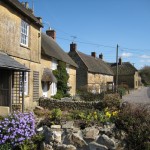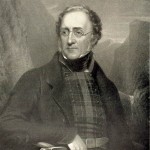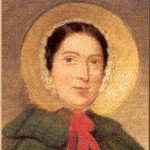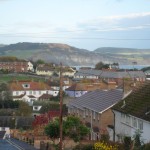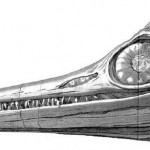How I Came to the Story
You might recall that George, one of the characters in my first novel, Reading by Lightning, studies paleontology and spends the summer in field school on the Dorset coast. In 2003, while I was researching for George’s summer in Lyme Regis and Charmouth, I came across accounts of the fossilist Mary Anning, digging on that very beach in a varnished top hat in the early 19th century. I knew in a flash that I would write a novel about her. I read about the early fossilists making their own sepia from 200 million year-old molloscs, and using it for their specimen drawings, and from that point on there was no turning back for me!
I spent a wonderful year reading (fossils, geology, regency England, Jane Austen, Thomas Hardy) and then took the first of three research trips to England. In Lyme Regis I stayed in a flat on Bridge Street, exactly where Mary Anning’s house once stood. For a prairie writer who has never lived by the sea, these were exhilarating weeks of walking the shore, getting familiar with the tides, exploring the Undercliff, absorbing everything I could about a new landscape. With a bit of perseverance, anyone can find fossils on Monmouth Beach or at Black Ven, and I now have my own tiny collection.
It was on the first research trip that the heart of Curiosity came to me. In the Natural History Museum in London, you can see Mary Anning’s hand-copied version of a scientific paper on one of her finds—a treatise on the Ichthyosaur by one of the scientific gentlemen who had appropriated her work. At the bottom of a page, Mary wrote a little note to herself: “When I write a paper, there shall not be but one preface.“ In that short sentence with its touching double negative, I saw her disaffection for the long-winded scientific gentlemen, her longing to be part of the establishment, to describe her own finds. Then in the Dorset County Museum, I read excerpts of the teenaged Anna Maria Pinney’s diary, in which she records her astonished reaction to the secret Mary Anning confessed about years of love and thwarted hopes.
Well, Curiosity will tell you where that led me. It was a journey filled with huge and unexpected pleasures.
As I conducted research, I was often amazed by what generous and accomodating collaborator history was; sometimes this book felt like a “found novel.” But of course I approached the facts as a novelist and not a historian, and I’m under no illusion that the Mary Anning and Henry De la Beche who became so real to me are history’s Anning and De la Beche.
Want to know more? Read . . .
The Dragon Seekers: How an Extraordinary Circle of Fossilists Discovered the Dinosaurs and Paved the Way for Darwin. By Christopher McGowan (Perseus Publishing, 2001; Basic Books, 2002). McGowan is an expert in marine reptile fossils (formerly a University of Toronto professor and curator of Palaeobiology at the Royal Ontario Museum), and he’s spent long chunks of time in the Lyme Regis area since childhood. He has both the scientific acumen and the skill as a storyteller to do justice to this account of scientific discovery and rivalry. It was after reading The Dragon Seekers that I decided to write Curiosity.
The Dinosaur Hunters by Deborah Cadbury (London: Fourth Estate, 2001) Another fine overview.
